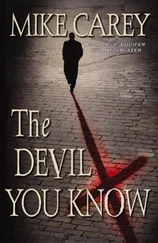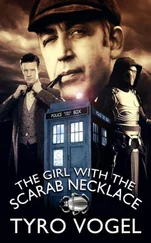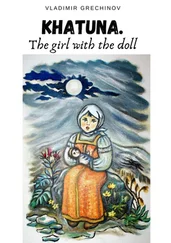Mike Carey - The Girl With All the Gifts
Здесь есть возможность читать онлайн «Mike Carey - The Girl With All the Gifts» весь текст электронной книги совершенно бесплатно (целиком полную версию без сокращений). В некоторых случаях можно слушать аудио, скачать через торрент в формате fb2 и присутствует краткое содержание. Год выпуска: 2014, ISBN: 2014, Издательство: Orbit, Жанр: Фантастика и фэнтези, на английском языке. Описание произведения, (предисловие) а так же отзывы посетителей доступны на портале библиотеки ЛибКат.
- Название:The Girl With All the Gifts
- Автор:
- Издательство:Orbit
- Жанр:
- Год:2014
- ISBN:978-0-316-27814-0
- Рейтинг книги:5 / 5. Голосов: 1
-
Избранное:Добавить в избранное
- Отзывы:
-
Ваша оценка:
- 100
- 1
- 2
- 3
- 4
- 5
The Girl With All the Gifts: краткое содержание, описание и аннотация
Предлагаем к чтению аннотацию, описание, краткое содержание или предисловие (зависит от того, что написал сам автор книги «The Girl With All the Gifts»). Если вы не нашли необходимую информацию о книге — напишите в комментариях, мы постараемся отыскать её.
The Girl With All the Gifts — читать онлайн бесплатно полную книгу (весь текст) целиком
Ниже представлен текст книги, разбитый по страницам. Система сохранения места последней прочитанной страницы, позволяет с удобством читать онлайн бесплатно книгу «The Girl With All the Gifts», без необходимости каждый раз заново искать на чём Вы остановились. Поставьте закладку, и сможете в любой момент перейти на страницу, на которой закончили чтение.
Интервал:
Закладка:
Dummy, dummy, dummy , Melanie scolds herself. Her rainforest picture is just full of branches. But the real branch looks different somehow. Its shape is more complicated and broken up, its textures rougher.
“You’re damn right it’s a branch,” Miss Justineau agrees. “I think it’s an alder. A couple of thousand years ago, the people who lived around here would have called this time of year the alder month. They used the bark of the tree for medicine, because it’s really rich in something called salicin. It’s kind of a natural pain relief drug.”
She goes around the class, unstrapping the children’s right arms from their chairs so that they can hold the branch and look at it right up close. It’s kind of ugly, Melanie thinks, but absolutely fascinating. Especially when Miss Justineau explains that the little green balls are buds–and they’ll turn into leaves and cover the whole tree in green, as though it’s put a summer dress on.
But there’s a lot more stuff in the bag, and when Miss Justineau starts to unpack it, the whole class stares in awe. Because the bag is full of colours–starbursts and wheels and whorls of dazzling brightness that are as fine and complex in their structures as the branch is, only much more symmetrical. Flowers.
“Red campion,” Miss Justineau says, holding up a spray that’s not red at all but sort of purple, each petal forked into two like the footprint of an animal in a tracking chart Melanie saw once.
“Rosemary.” White fingers and green fingers, all laced together like your hands clasped together in your lap when you’re nervous and you don’t want to fidget.
“Daffodils.” Yellow tubes like the trumpets angels blow in the old pictures in Miss Justineau’s books, but with fringed lips so delicate they move when Miss Justineau breathes on them.
“Medlar.” White spheres in dense clusters, each one made out of overlapping petals that are curved and nested on themselves, and open at one end to show something inside that looks like a tiny model of more flowers.
The children are hypnotised. It’s spring in the classroom. It’s equinox, with the world balanced between winter and summer, life and death, like a spinning ball balanced on the tip of someone’s finger.
When everyone has looked at the flowers, and held them, Miss Justineau puts them in bottles and jars all around the classroom, wherever there’s a shelf or a table or a clear surface, so the whole room becomes a meadow.
She reads the class some poems about flowers, starting with one by Walt Whitman about lilacs and how spring always comes back again, but Walt Whitman hasn’t got very far at all before he’s talking about death and offering to give his lilacs to a coffin that he’s seen, so Miss Justineau says let’s quit while we’re ahead and reads Thomas Campion instead. He even has the same name as a flower, Melanie thinks, and she likes his poem a whole lot better.
But maybe the most important thing that comes out of this day is that Melanie now knows what date it is. She doesn’t want to stop knowing again, so she decides to keep count.
She clears a place in her mind, just for the date, and every day she goes to that place and adds one. She makes sure to ask Miss Justineau if this is a leap year, which it is. Once she knows that, she’s good.
Knowing the date is reassuring in some way she can’t quite figure out. It’s like it gives her a secret power–like she’s in control of a little piece of the world.
It’s not until then that she realises she’s never had that feeling before.
7
Caroline Caldwell is very skilled at separating brains from skulls. She does it quickly and methodically, and she gets the brain out in one piece, with minimal tissue damage. She’s reached the point now where she could almost do it in her sleep.
In fact, it’s been three nights since she slept, and there’s an itchiness behind her eyes that isn’t eased by rubbing them. But her mind is clear, with only the very slightest sense of a hallucinatory edge to that clarity. She knows what she’s doing. She watches herself do it, approving the virtuosity of her own technique.
The first cut is to the rear of the occipital bone–easing her slimmest bone-saw into the gap that Selkirk has opened up for her, through the peeled-back layers of flesh and between the nubs and buds of exposed muscle.
She extends that first cut out to either side, taking care to maintain a straight horizontal line corresponding to the widest part of the skull. It’s important to have enough room to work in, so she doesn’t squash the brain or leave part of it behind when she takes it out. She journeys on, the bone-saw flicking lightly back and forth like the bow of a violin, through the parietal and temporal bones, keeping the same straight line, until she comes at last to the superciliary ridges.
At that point, the straight line ceases to matter. Instead, X marks the spot; Dr Caldwell draws the saw down from top left to bottom right, then up again from bottom left to top right, making two slightly deeper incisions that cross at the midpoint between the subject’s eyes.
Which flicker in rapid saccades, focus and defocus in restless busy-work.
The subject is dead, but the pathogen that controls his nervous system isn’t even slightly deterred by the loss of a steering consciousness. It still knows what it wants, and it’s still the captain of this sinking ship.
Dr Caldwell deepens the intersecting cuts at the front of the skull, because the subject’s sinuses in effect create a double thickness of bone there.
Then she puts down the bone-saw and picks up a screwdriver–part of a set that her father received as a free gift from the Reader’s Digest publishing company when he subscribed to some of their products more than thirty years previously.
The next part is delicate, and difficult. She probes the cuts with the tip of the screwdriver, levering them further open where she can, but making sure that she never inserts the screwdriver’s business end deep enough to damage the brain beneath.
The subject sighs, although he has no need for oxygen any more. “Soon be done,” Dr Caldwell says, and feels foolish a half-second later. This is not a conversation, or a shared experience of any kind.
She sees Selkirk watching her, with a slightly guarded expression. Piqued, she snaps her fingers and points, making Selkirk pick up the bone-saw and hand it back to her.
Now she’s engaged in a ballet of infinitesimal increments–testing the skull with the tip of the screwdriver to see where it moves, going in with the saw again where there’s resistance, and gradually levering the whole top of the skull loose in one piece.
Which is the hardest part, now done.
Lifting the front of the calvarium, Caldwell snips loose cranial nerves and blood vessels with a number ten pencil-grip scalpel, lifting the brain gently from the front as it comes free. Once the spinal cord is exposed, she cuts that too.
But she doesn’t try to lift the brain all the way out. Now that it’s free, she hands the scalpel back to Selkirk and accepts a pair of snub-nosed pliers, with which she removes, very carefully, the few jagged edges of bone that stand proud from the rim of the hole she’s made in the skull. It’s all too easy to gouge troughs in the brain as you lift it through that makeshift trapdoor, and then it’s of such limited use you might as well throw it away.
Now she lifts it; with both hands, from underneath, teasing it up with the tips of her fingers through the opening in the skull without ever letting it touch the edge.
And sets it down, with great care, on the cutting board.
Subject number twenty-two, whose name was Liam if you accept the idea of giving these things a name, continues to stare at her, his eyes tracking her movements. It doesn’t mean he’s alive. Dr Caldwell takes the view that the moment of death is the moment when the pathogen crosses the blood–brain barrier. What’s left, though its heart may beat (some ten or twelve times per minute), and though it speaks and can even be christened with a boy’s name or a girl’s name, is not the host. It’s the parasite.
Читать дальшеИнтервал:
Закладка:
Похожие книги на «The Girl With All the Gifts»
Представляем Вашему вниманию похожие книги на «The Girl With All the Gifts» списком для выбора. Мы отобрали схожую по названию и смыслу литературу в надежде предоставить читателям больше вариантов отыскать новые, интересные, ещё непрочитанные произведения.
Обсуждение, отзывы о книге «The Girl With All the Gifts» и просто собственные мнения читателей. Оставьте ваши комментарии, напишите, что Вы думаете о произведении, его смысле или главных героях. Укажите что конкретно понравилось, а что нет, и почему Вы так считаете.












